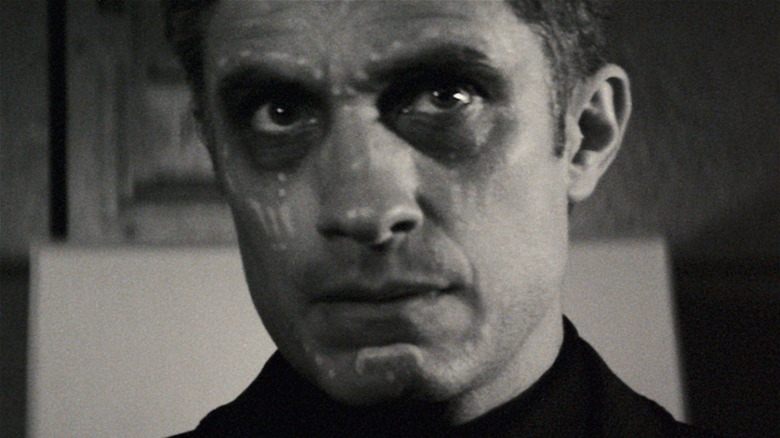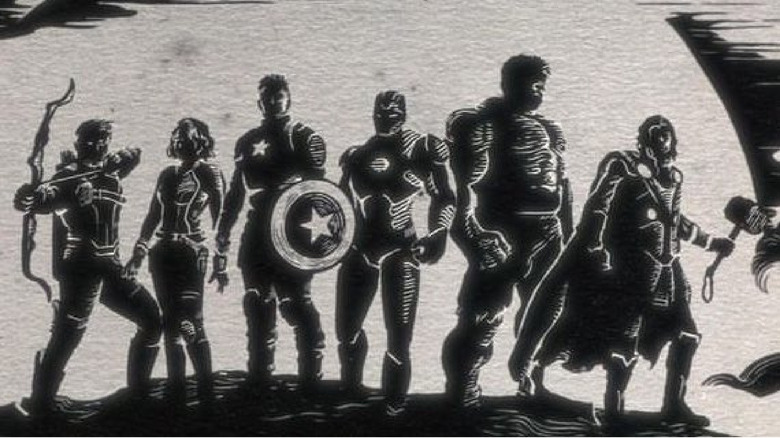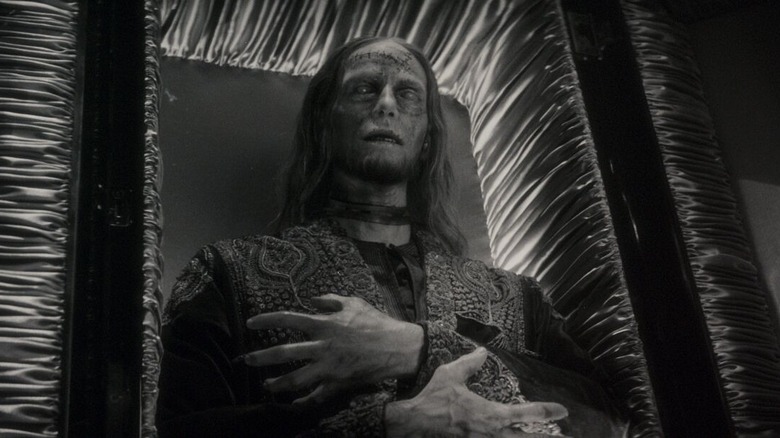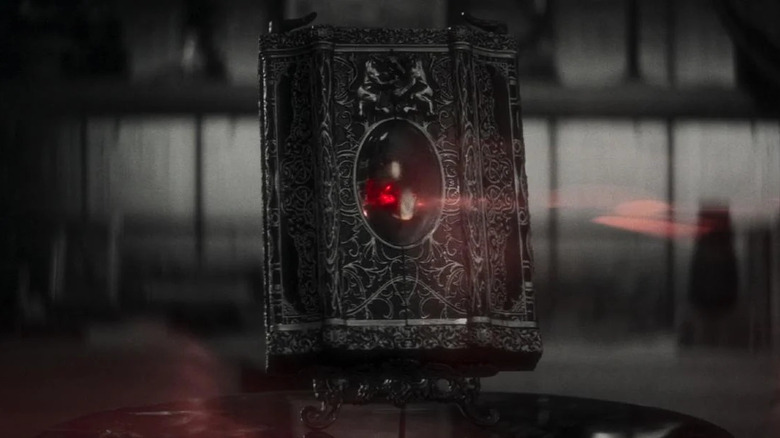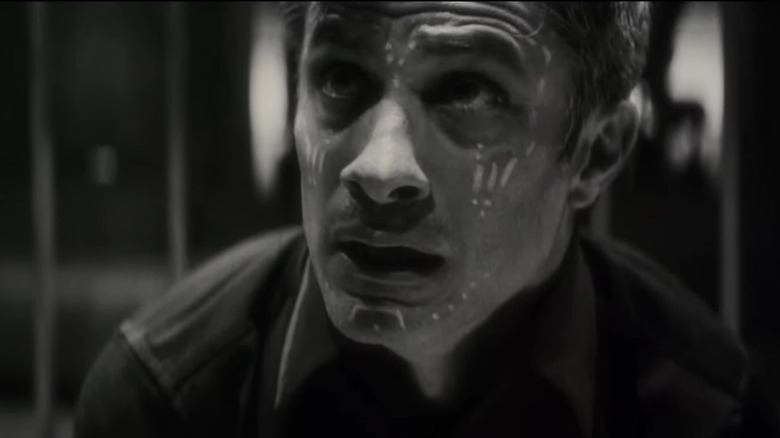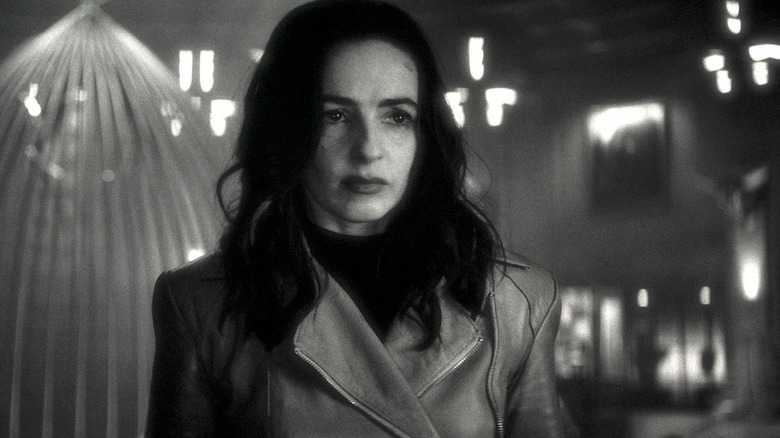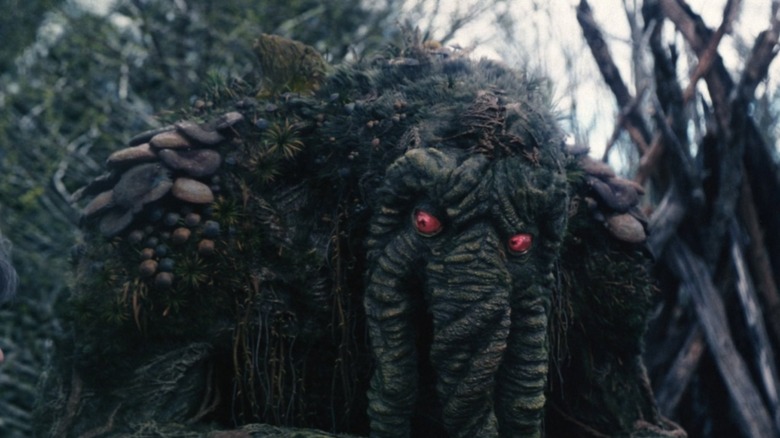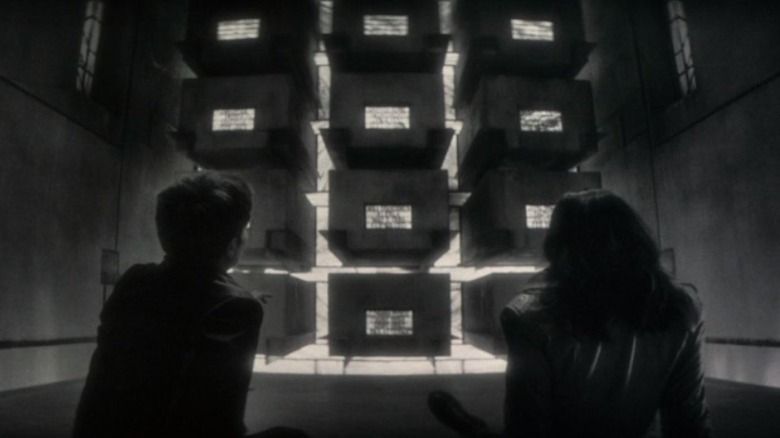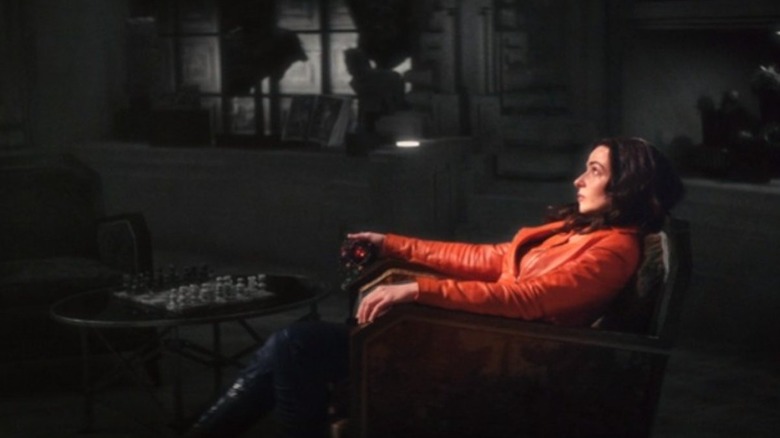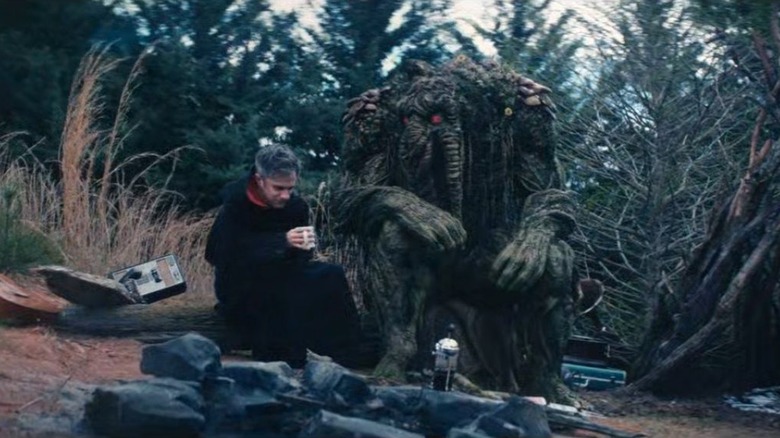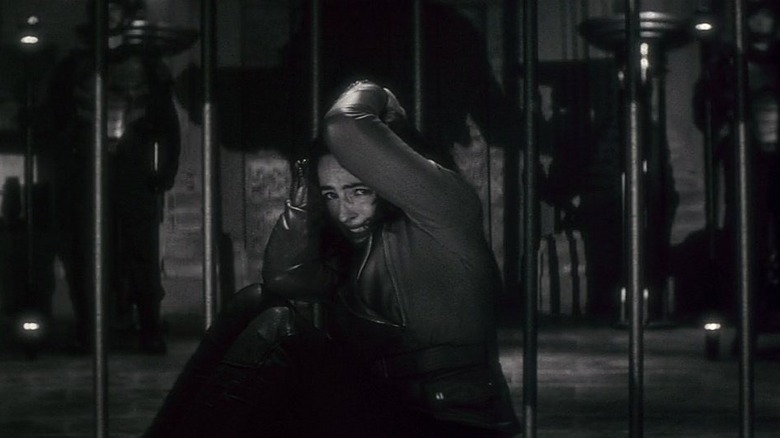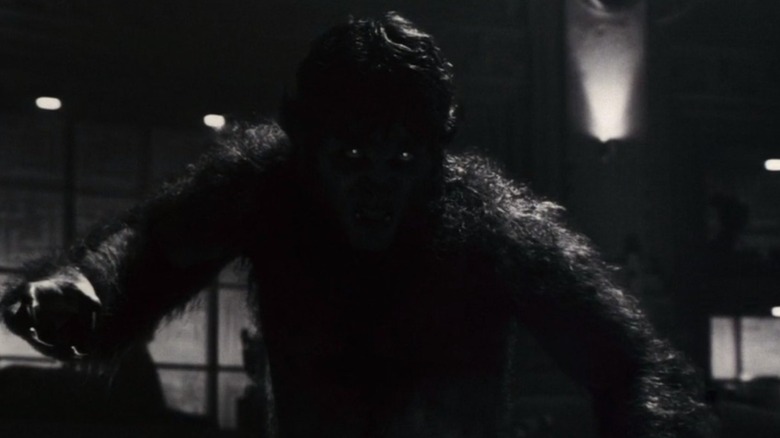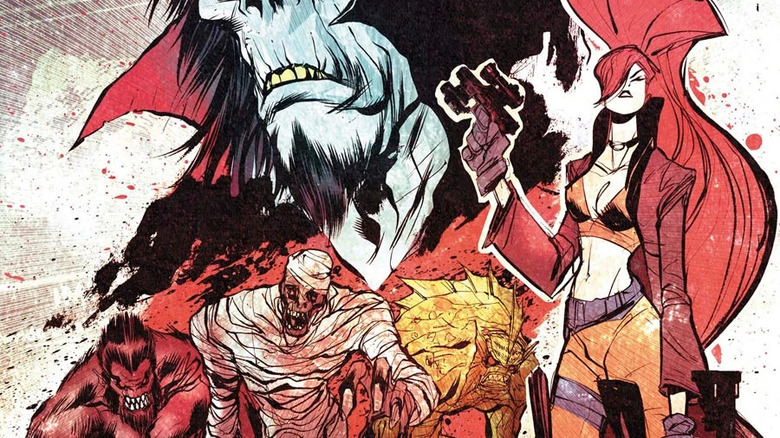Small Details You Missed In Werewolf By Night
A new entry in the Marvel Cinematic Universe has dropped on Disney+ just in time for the spookiest season of the year. "Werewolf by Night," labeled a Marvel Studios Special Presentation, stars Gael García Bernal as Jack Russell, a monster hunter who transforms into a vicious, out-of-control monster when the full moon shines. Alongside García Bernal stars Laura Donnelly as Elsa Bloodstone, the iconic Marvel Comics monster hunter who makes her MCU debut.
Directed by Michael Giacchino, best known for his work on the music of the Marvel Cinematic Universe, "Werewolf by Night" is a tribute to the horror of the 1930s, '40s, and '50s (via Polygon). The entire special plays out in cinematic black-and-white, giving it the makings of a modern Halloween classic. Though it doesn't have the depth of a typical MCU series or movie, it's still a delightful horror romp that opens up new doors for the MCU's future.
Given its short length and relatively low-key release, some Marvel fans might miss "Werewolf by Night," especially as it started airing just before the season finale of "She-Hulk: Attorney at Law" and only a month before the highly-anticipated "Black Panther: Wakanda Forever." That's a shame, however, as the special is chock-full of details that may excite not only fans of Marvel Comics, but fans who want more of Marvel's ongoing foray into horror.
A new corner of the Marvel Cinematic Universe
Right from the start, "Werewolf by Night" introduces itself as a new beginning for the MCU. The typical Marvel splash intro is interrupted by claw marks as it fades to the special's signature black-and-white aesthetic. After the opening titles, the special opens on a drawing of the original six Avengers: Hawkeye, Black Widow, Captain America, Iron Man, Hulk, and Thor, as a "The Twilight Zone" style narration welcomes audiences to a new side of the Marvel universe: the "darkness."
Although the world of monsters has origins in Marvel Comics predating some of the MCU's most iconic characters, "Werewolf by Night" marks the franchise's official introduction to this side of Earth-616. However, with the existence of monsters comes the necessity for monster hunters to protect the human world from these supernatural beings.
That being said, diehard Marvel fans will know there's been groundwork set for this in previous MCU projects. The Disney+ series "Moon Knight" explored new mythology in the Marvel universe, while "Doctor Strange in the Multiverse of Madness" delved into the occult texts and witchcraft audiences first encountered in "WandaVision." While the world of monster hunters is brand-new for the MCU, it definitely will have an impact on the characters we've seen before.
The legend of Ulysses Bloodstone
"Werewolf by Night" begins with an introduction to the most significant family of monster hunters in the Marvel universe, the Bloodstones. Its patriarch, Ulysses, is in possession of a relic known as the Bloodstone gem, which is the source of his strength. However, Ulysses' death means that several triumphant monster hunters have arrived at his funeral to compete for possession of the powerful object.
Of course, this introduction to Ulysses Bloodstone has many echoes in Marvel Comics. The character was first introduced in "Marvel Presents: Bloodstone" in 1975 and made recurring appearances as Marvel's signature monster hunter for many years. He was finally killed off in "The Rampaging Hulk" #8 after sacrificing his immortality to destroy an interdimensional race of deities known as the Exo-Mind.
However, Ulysses' role in "Werewolf by Night" is, more importantly, a way to introduce Marvel fans to Elsa Bloodstone, his successor who will no doubt be important to MCU projects going forward. Hopefully, in future MCU projects, Elsa's involvement will be a way for viewers to learn more about Ulysses himself and his various conquests over the years. As his trophy-filled manor suggests, Ulysses has made a lot of enemies throughout the centuries he spent hunting — and some of these prizes may allude to future conflicts for Elsa.
An immortal gem known as Bloodstone
Of course, it wouldn't be a tribute to classic Hitchcockian horror without the appearance of a MacGuffin. The term describing an object that a film's plot centers on certainly applies to the Bloodstone gem, which takes center stage in "Werewolf by Night" as the object pursued by the hunters. The Bloodstone not only grants its wielder immense strength but near-immortality, which was taken advantage of by Ulysses Bloodstone to become a legendary monster hunter (via Den of Geek).
However, according to producers of "Werewolf by Night," there's more to the Bloodstone than meets the eye. In an interview with The Direct, "Werewolf by Night" producer Brian Gay described the stone's ability to control monsters, which explains how it weakens Jack and the Man-Thing during the events of the special. Now that it's in the hands of a character like Elsa Bloodstone, this object could be used against many different threats in the MCU.
If the MCU continues to follow comic lore, there are even more powers that could be hidden in the Bloodstone, which was originally called the Bloodgem. In fact, Marvel Comics lore explains that the Bloodstone was actually halved, with one half going to Elsa and the other going to Ulysses' son, Cullen. There's no mention of Cullen's existence in "Werewolf by Night," but perhaps if there's another piece of the Bloodstone out there, Elsa could be determined to find it.
Jack Russell's lycanthropic origins
Most of "Werewolf by Night" focuses on the special's titular monster, who disguises himself as a monster hunter named Jack Russell. Though little is revealed about Jack's backstory in the special, it's clear his transformation into a werewolf is no new struggle. Given the mysteries surrounding Jack's MCU origins, there are a lot of ways his past could connect to other characters and aspects of the Marvel universe.
Jack Russell made his comic debut in 1971 before getting his own solo series called "Werewolf by Night" a year later. Jack's ancestor, Grigori, fought Dracula in 1795, later inheriting a curse from the Darkhold that forced him to transform into a werewolf every full moon (via Marvel). Eventually, this curse was inherited by Grigori's descendants. This includes Jack, who began his transformations following the death of his mother.
The Darkhold is incredibly familiar to Marvel fans, as it played a big role in "WandaVision" and "Doctor Strange in the Multiverse of Madness" as the source of Wanda's chaos magic. However, now that it's been destroyed by Wanda, it remains a question how Jack's curse still afflicts him. Nevertheless, Jack likely has some big foes on the horizon in the Marvel universe, as his solo comic series was originally where the character of Moon Knight was introduced.
Meet Elsa, the MCU's newest monster hunter
Laura Donnelly makes her MCU debut as Elsa Bloodstone, the daughter of Ulysses Bloodstone and heir to his monster-hunting legacy. By the end of "Werewolf by Night," Elsa has taken possession of the Bloodstone gem, granting her the powers and immortality to become the next big threat in Marvel's supernatural world. Fortunately, this likely means Elsa will be showing up quite a lot in future MCU projects, especially ones that will dive further into the world of monsters.
Elsa's comic book debut came back in 2001 in a mini-series following her taking up her father's mantle. Since then, she's become a popular recurring character in Marvel Comics, particularly in her interactions with Deadpool, Dane Whitman, and Captain Britain. She's also been a member of teams like the Defenders and the Midnight Sons, the latter of which may be in the MCU's near future with the inclusion of characters like Moon Knight, Blade, and Doctor Strange.
While Elsa makes a big impression on audiences in "Werewolf by Night," this is only the beginning of the journey for Donnelly's ruthless monster killer. She may reappear as early as 2023's "Blade," where she could join forces with Mahershala Ali's titular vampire hunter.
The man behind the Man-Thing
Another surprisingly endearing character who appears in "Werewolf by Night" is Ted, known in the comics as Man-Thing. The character is introduced as the target monster of all the hunters attending Ulysses' funeral, but his first interactions with Jack prove that he's simply a kind monster in need of rescuing. Fortunately, Jack makes a pact with Elsa to give her the Bloodstone in exchange for Ted's freedom, and the special ends with Jack and Ted camping together.
While calling the Man-Thing "Ted" works as an adorable joke in "Werewolf by Night," it has important origins in the comics. Man-Thing's original identity was as a biochemist named Theodore Sallis, who, in a failed attempt to recreate the Super Soldier Serum, becomes a swamp monster (via Polygon). Later on in the comics, the Man-Thing becomes the guard to the Nexus of All Realities, an interdimensional gateway that the Watcher resides in during the animated Disney+ series, "What If...?"
It's unlikely that this version of Ted has such a high duty yet, as he can barely stay safe from getting captured and used as monster hunter bait. Nevertheless, he and Jack will likely show up again at some point in the MCU, where hopefully they'll keep each other out of trouble for as long as they can.
A mausoleum dedicated to Marvel artists
About halfway through "Werewolf by Night," Jack Russell and Elsa Bloodstone find themselves locked inside a mausoleum containing the coffins of Elsa's ancestors. It's a slower moment for the fast-paced special, allowing the two to bond and form a pact away from the other hunters. Some viewers may find themselves drawn in this scene to the names on these tombs, but unlike other MCU projects, there aren't as many Easter eggs hidden here as one would think.
However, one interesting Easter egg in this scene that fans may notice is a tombstone marked "Mika Brandonen Kleyla," which is a reference to an art director and friend of director Michael Giacchino, Brandon Kleyla. While Kleyla has no specific ties to the MCU, he has done plenty of work for Disneyland and Disney World resorts across the world. Another tombstoned marked "Jacob Howell Macdougall" references a VFX assistant for Marvel Studios, and another references "Werewolf by Night" propmaker David Long.
The biggest reference hidden among these tombs is perhaps a tomb labeled "Brian Gay," which references one of the executive producers of "Werewolf by Night" of the same name. Gay's previous MCU credits include "Loki," "Avengers: Endgame," and "Black Panther," among other Phase 3 and 4 projects.
Elsa takes control of her legacy
The ending of "Werewolf by Night" finds Elsa Bloodstone rightfully winning the monster hunter competition, possession of the magical powers of the Bloodstone, and ownership of her father's estate. This sets Elsa up to have a similar trajectory in the Marvel Cinematic Universe that she does in the comics, becoming the heir to her father's legacy and controlling the Bloodgem itself.
In the comics, Elsa comes into possession of the Bloodgem when she inherits her father's manor, the Bloodstone Curios. This is where she spends most of her time while not chasing down various supernatural threats. However, it's also likely that by the next time we see Elsa in the MCU, she has become quite adept at dealing with magic. For instance, her appearance in the 2021 comic mini-series "Black Knight: Curse of the Ebony Blade" found her butting heads with the sword-wielder, Dane Whitman, over his incompetence in dealing with powers out of his control. Perhaps Elsa will have a future interaction with Dane, who debuted in 2021's "Eternals" played by Kit Harington.
It's unclear how much Elsa derives from her comic book origins, but future appearances will inform viewers how important it is that she comes into the possession of the Bloodgem by the end of this special. In the comics, the Bloodgem gives her certain abilities and near-immortality, but a lot of her powers — such as her immunity to vampire bites — come from genetics.
Somewhere over the rainbow
In the final moments of "Werewolf by Night," the special transitions from black-and-white to color, officially marking its inclusion into the wider Marvel Cinematic Universe. There are splashes of color throughout the special, with the Bloodstone glowing red throughout, but once Elsa sits with the gem at the end of the special, her world transforms into color. When the scene cuts to Jack and Ted camping, the special has completely become Technicolor, retaining a certain resemblance to the color films of the '30s and '40s.
This Technicolor atmosphere is even further referenced by the music that plays over the ending. "Somewhere Over the Rainbow," famously sung by Judy Garland in 1939's "The Wizard of Oz," begins as the special transitions to color. Obviously, transitioning from black-and-white to color is a blatant reference to "The Wizard of Oz," which spends most of its runtime in Technicolor after a beginning in a sepia tone.
However, unlike "The Wizard of Oz," the events of this special were no dream. Still, as the song plays over a scene of Ted and Jack camping together, one can't help but wonder if Judy Garland's song somehow relates to the future of Ted and Jack's story. It's unknown what they plan to do now that they're free, but perhaps it has something to do with going home.
A tribute to horror in early cinema
Part of the appeal of "Werewolf by Night," both for viewers and for first-time director Michael Giacchino, was the fact that it serves as a mini-tribute to the early days of the horror genre. From the get-go, Giacchino likened the film's style to an episode of "The Twilight Zone," examining the lives of Jack and Elsa over the course of one terrifying night (via Polygon). The special even begins with a voiceover intro reminiscent of Rod Serling's iconic "The Twilight Zone" monologues.
Other films Giacchino has cited as references for "Werewolf by Night" clearly show how the special embodied classic black-and-white horror. Particularly, the Universal Studios horror films like "The Wolf Man," "Creature from the Black Lagoon," and "King Kong" influenced the special in terms of its practical effects. With the design of Jack Russell's werewolf form, Giacchino opted for prosthetic makeup for Gael García Bernal rather than CGI. This, as well as the special effects throughout "Werewolf by Night" that allow for less VFX, make it an aesthetic Marvel hasn't attempted before.
As noted by Variety, "Werewolf by Night" also features a fair share of gore. Characters get their arms ripped off and blood splatters the camera lens. However, as Giacchino explained to The Hollywood Reporter, the use of black-and-white photography helped the special satisfy a TV-14 rating as opposed to TV-MA. Like the early episodes of Marvel's first Disney+ project, "WandaVision," Marvel gets a lot of mileage out of telling a story through the eyes of a genre from cinema's past.
Jack, Elsa, and Ted in the MCU's future
As is the case with any new MCU project, fans are eager to know when the new characters we've been introduced to will be seen again. In "Werewolf by Night," three new players in the larger MCU are introduced: Jack Russell, aka Werewolf by Night, Ted the Man-Thing, and Elsa Bloodstone. The comic book counterpart of each of these characters is incredibly important in the grand scheme of the Marvel universe, particularly in their connections to the world of monsters (via IGN).
The most visible of these characters will likely be Elsa Bloodstone, who has a long history in the Marvel Comics universe despite only being introduced as early as 2001. The character has crossed paths before with Deadpool, Dane Whitman, and Doctor Strange, all of whom have made their live-action debuts already. She, Jack Russell, and Man-Thing also have close connections with the Midnight Sons, a superhero team that has also included Blade, Master Wong, Morbius, Ghost Rider, and Moon Knight.
Blade, in particular, might be the key to Elsa, Jack, and Ted's futures. The character has already met Dane Whitman as of the "Eternals" post-credits scene and was considered for an appearance in "Werewolf by Night." Perhaps Elsa or Jack will have big roles to play in the forthcoming "Blade" movie, which is in pre-production but without a director. Hopefully, Michael Giacchino will step up to the plate and bring his love of horror to that Phase 5 film.
The beginning of the Legion of Monsters
Another important superhero group that might be teased by the ending of "Werewolf by Night" is the Legion of Monsters. In the comics, the Legion of Monsters is united by a being called the Starseed which claims to cure their monstrous forms. Werewolf by Night and Man-Thing were joined by Morbius the Living Vampire, the Living Mummy, and Manphibian to form the original line-up of the Legion of Monsters.
Other members of the Legion of Monsters include Elsa Bloodstone, who certainly has a great reason to remain an ally of Jack and Ted after the events of "Werewolf by Night." Another vital member of the group is Frank Castle, aka the Punisher, who is brought back to life as Frankencastle and helps them before Elsa returns him to his human form.
With Jack Russell and Man-Thing as a traveling duo, they may yet find more monsters to rescue and join their crew of monster hunters. Nevertheless, it's clear that "Werewolf by Night" contains a lot of clues as to where the future of the MCU's monsters may be heading. Whether it's superhero team-ups or continuing the individual stories of some of these new and lovable characters. Hopefully, Marvel producer Kevin Feige recognizes how much fans love the studio's forays into horror after this Halloween special, the Disney+ series "Moon Knight," and the Sam Raimi-led "Doctor Strange in the Multiverse of Madness."
